Compartment 17 comprises eight subcompartments, all on the north side of Bury's Bank Road, and separated by a number of properties. Subcompartments 17B, C (part) and D are accessible to grazing stock, which is able to cross the road on the section between the two cattle grids. 17B includes the car parking area for BBOWT's adjacent Bowdown Woods nature reserve.

General description and evaluation of ecology
The habitats consist of a rich mix of woodland, small remnant areas of heathland, grassland and wet wooded gullies. More detail is given in the individual subcompartment descriptions below.
BAP habitats
- Lowland heathland (17B)
- Lowland dry acid grassland (17B)
Higher Level Stewardship
Options exist for this compartment.
- HO1 (Maintenance of lowland heathland) (17B, 17C, 17D)
Overall management objectives
Maintain areas of mature woodland and increase areas of acid grassland and heathland by reducing the extent of bracken, scrub and secondary birch woodland.
Subcompartment 17A: Pigeons Farm Road (1.0 ha)
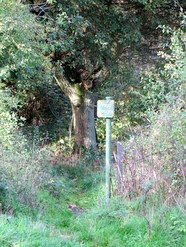
Situated next to a housing estate and Crookham Golf Course, this small mixed secondary woodland has a few large oaks and mixed tree and shrub species, including sycamore and numerous horse chestnuts. The ground layer contains an extensive colony of pignut with associated bluebells. Wood sage and bramble occur throughout. A concrete stand and surrounds have a variety of pioneer species, notably shining crane's-bill, local and rather rare in Berkshire. One of the few public rights of way on the common crosses the subcompartment just inside its eastern edge.
| Objective | Area | Method | Comment |
|---|---|---|---|
| 17A.1) Diversify woodland structure. | All woodland. | Occasional selective felling of sycamores with follow up stump treatment. Leave large specimens. Focus on areas with rich ground flora, and on maintaining the public footpath by cutting back encroaching vegetation. Remove rhododendron, monitor holm oak and cotoneaster and control these if necessary. Maintain openness of the concrete pan, occasionally scraping back small areas to reset succession in favour of pioneer species. |
Subcompartment 17B: Approach to Bowdown Woods (9.7 ha)
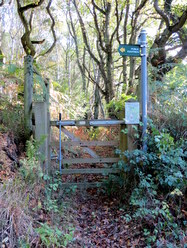
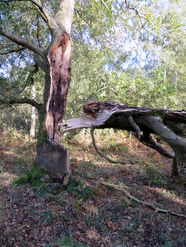
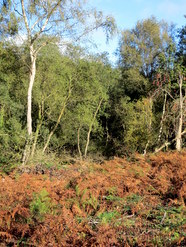
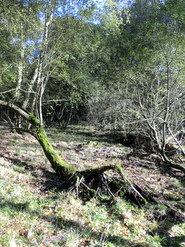
This area is mainly wooded but also contains a complex of habitats including heathland/grassland restoration areas and two wet wooded gullies which join and then drain off the common to the east. The wet gullies contain shallow pools, mires and runnels supporting bog pondweed as well as tussocks of purple moor grass, sphagnum, lesser skullcap and bog pimpernel, a rare and declining species in Berkshire. In the lower section of the watercourse, ash and alder coppice woodland occur and opposite-leaved golden saxifrage can be found. At the head of one of the gullies, bamboo formerly spreading from a property has (2013) been substatially cleared but a few stalks are still present.
Where older woodland is found amongst the birch dominated areas and open bracken glades, there are large oaks with small populations of Solomon's seal, pignut and bilberry. The boundaries of the common are also marked by banks, some big, with large notable trees. Holly is frequent and there is a small Scots pine plantation in the south-eastern section. On the plateau there are remnant, somewhat isolated patches of heathland with common and bell heather along with small areas of grassland. Significant areas of trees and scrub were cleared during 2011 to 2013 as part of the West Berkshire Living Landscape heathland restoration project. The more open areas with remnant heath and scrub have been used by nightingales.
There are access tracks for a number of properties, and a tarmac track giving access to the "bomb site" car park for Bowdown Woods nature reserve. This track is part of the Living Landscape circular walk nr 1. The northern part of the subcompartment has a formally designated permissive path, roughly parallel with Bury's Bank Road, linking to a public right of way running (not on the common) north into the Kennet valley.
| Objective | Area | Method | Comment |
|---|---|---|---|
17B.1) Increase current extent of heathland and grassland areas.
HLS objectives |
All current areas of heathland but predominanty either side of Bowdown Woods approach road, the two areas of neutral grassland, and around the car park area. | Remove sycamores, clear fell areas of silver birch and treat stumps. Leave larger, single specimens of oak and birch. Treat bracken and create scrapes, aiming for 1% to 5% bare ground. Scatter heather seeds or clippings if regeneration is poor. Make small scrapes in the soil layer developing over old tarmac tracks, to reset succession in favour of pioneer species. Mow sections of grassland periodically to control brambles and scrub. Coppice gorse in a rotation to diversify the structure, and allow to re-grow where it does not compete with heather. Retain a woodland and gorse screen alongside Bury's Bank Road. Keep the permissive path and other well-used paths clear of encroaching scrub. |
Discourage fly tipping and dumping of garden waste. Part of this area was included in the BBOWT West Berkshire Living Landscape project area for heathland restoration works 2011 - 2013. |
| 17B.2) Maintain current extent and diversity of mature oak woodland, wet alder and willow gullies and associated ground flora. | All woodland. | Keep open pools and mires free of cover, especially willows around flush with bog pimpernel. Sufficient clearance so that the ground flora is not shaded out. Cut and treat southerly willows, leaving some to re-grow. Substantially open the southern branch of the gully system. Leave some alder and ash on stream edges to succeed without intervention. Fell and stump-treat trees around pill-box type structure (HEMP feature 297) to avoid root damage to brickwork. Retain pine plantation. |
Protect historic banks and large trees from encroachment and damage. Liaise with adjacent landowners on importance of banked boundaries and trees. |
| 17B.3) Remove bamboo from wet gully. | Adjacent to property. | Cut and/or pull every year. | Neighbouring landowner has eredicated bamboo from the source area. |
Subcompartment 17C (1.7 ha)
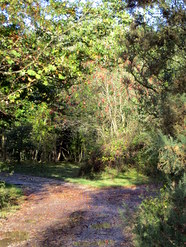
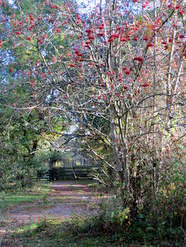
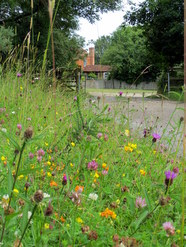
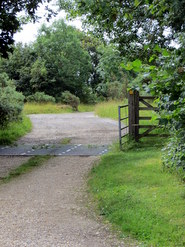
This relatively small area comprises a mix of secondary woodland, scrub and neutral grassland, all dissected by tracks to private properties. In the woodlands, mature hawthorns and apple trees are particularly evident and a steep slope to the west side contains dense holly under beech and oak trees with a very sparse ground flora. The concrete of former aircraft dispersal areas and old building bases underlies some areas. Where the woodland opens out towards the east, a banked gravelly area over one such concrete pan supports neutral grassland with a rich flora including numerous cowslips, and (2014) with vigourously colonising gorse. The northernmost section of 17C adjacent to several properties, being outside the stock fence, is ungrazed and is maintained mainly as mown grass by residents.
| Objective | Area | Method | Comment |
|---|---|---|---|
17C.1) Maintain current extent of grassland areasHLS objectives |
Gravel over concrete former dispersal area. | Remove and treat scrub, especially gorse. | Minimal intervention in the northern area currently (2014) maintained by residents. |
| 17C.2) Diverisfy woodland structure. | Open small, sunny glades to maintain an open canopy and allow to re-grow. |
Subcompartment 17D (5.1 ha)
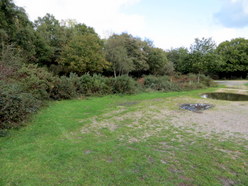
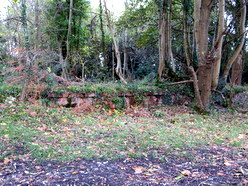
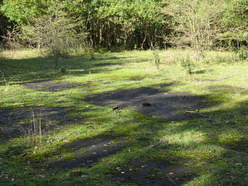
This area comprises a mixture of mature and secondary oak and birch woodland around several tracks and access roads, and contains brick structures and concrete and tarmac pads from military history, mainly in the western half of the subcompartment.
Gorse scrub with bracken is (2014) becoming dominant around an informal roadside car parking spot, with leggy degenerate gorse alongside the road to the east. The mature oak woodland includes a scattering of other native tree species and a few sycamores, with frequent holly thickets and occasional glades of grassland and bracken. In the pockets of neutral and acid grassland, bird's-foot can be found growing on anthills. A wet flush forming a clearing in the woodland in the north of 17D contains rushes, great horsetail and bog stitchwort. Parts of the northern boundary are marked by a bank with some impressively large oaks. An invasive yellow-flowered balsam species is present in the east of the subcompartment.
| Objective | Area | Method | Comment |
|---|---|---|---|
17D.1) Maintain current extent of grassland areas.HLS objectives |
All current extent of grassland, especially along roadside and car park area. |
Coppice gorse in a rotation to diversify the structure and treat stumps where it does not compete with grassland. Keep gorse and scrub clear of anthills on western end of compartment. Maintain some gorse screening alongside the road. Maintain openness of glades. Scrape small patches over concrete and tarmac pans to reset succession. |
Fly tipping has been a problem here. Keeping gorse short will help alleviate this. |
| 17D.2) Restore heathland and acid grassland. | Towards west of subcompartment. | Spray bracken and scarify soil to encourage heather regeneration. | |
| 17D.3) Maintain openness of marshy glade. | North of subcompartment. | Cut and treat scrub. | |
| 17D.4) Maintain current extent and diversity of woodland. | All woodland. | Minimum intervention. Eliminate exotic invasive balsam in east of subcompartment by pulling or cutting. Liaise with neighbouring landowner. |
Protect brick structures from tree root damage.
Maintain scrub/woodland screen to road for local residents. |
Subcompartment 17E (0.7 ha)
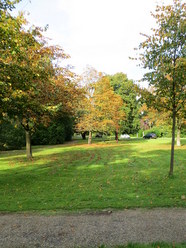
This is a narrow roadside patch of grassland locally known as School Green, regularly mown with a well used, surfaced path.
Continue with regular contracted mowing and bollard maintenance.
Subcompartment 17F: Entrance to Pigeon's Farm track (0.3 ha)
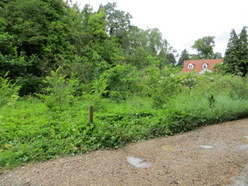
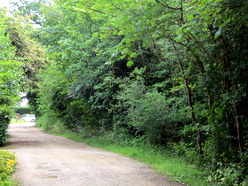
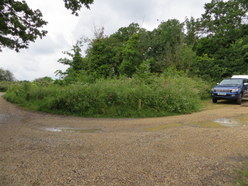
This is a small, dense fragment of woodland with a fringe of grassland on its eastern end, both containing vigorously suckering English elm. The woodland contains a large quantity of deadwood, with copious ivy growing in the trees. Pignut occurs in small numbers amongst a number of garden shrubs and herbs both introduced and planted. The grassland contains common spotted and pyramidal orchids, but is (2014) being overrun by a thick carpet of ground elder.
Re-start mowing of the grassland. Control ground elder. Remove rhododendron and some sycamore. Monitor laurel and snowberry, control these if necessary. Otherwise maintain current extent of woodland by minimal intervention.
Subcompartment 17G: East of Crookham Golf Clubhouse (1.1 ha)
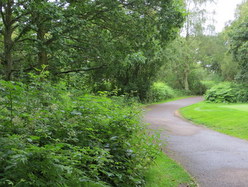
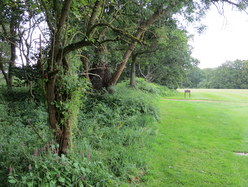
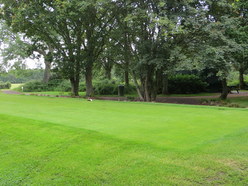
This is a narrow straight strip of woodland between the golf course and the road, developing in the east into a broader, roughly tiangular parcel of woodland projecting into the golf course. The woodland contains oak standards, birch and wild cherry, with Scots pine lining part of the golf course boundary. Gorse, bramble, bracken and bluebells occur in the ground layer. Nightingales are reportedly heard singing from the dense scrub layer in the narrow strip next to the road.
No trace of a boundary bank, mentioned in an earlier survey, could be found during a site visit in June 2014. Parts of the boundary between the common and the golf course are poorly defined and should be protected from encroachment.
Maintain current extent of woodland by minimal intervention.
Ensure boundary is evident.
Subcompartment 17H (0.1 ha)
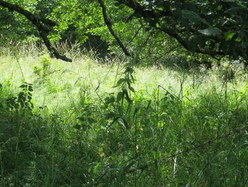
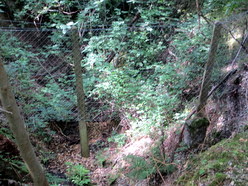
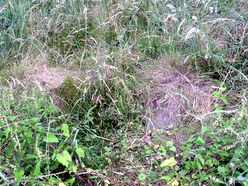
This is a small area of mixed secondary woodland with some grassy glades, and one very distinct drainage gully, partly concreted but now (2014) in disrepair and actively eroding. Being outside the grazed area of the main common, the grassland provides a different habitat (for example, supporting numerous anthills).
Maintain or expand current extent of grassland by controlling invading trees and bramble scrub.
Ensure boundary is evident.